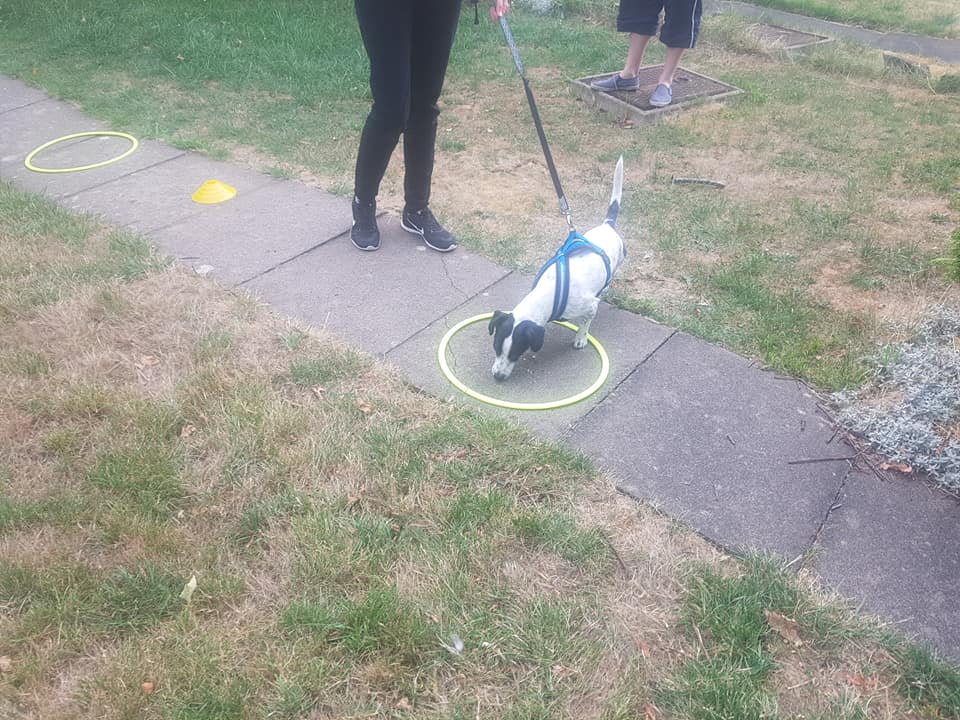Introduction
Some anxious dogs need an extra outlet to remove the focus from the ‘scary thing’. They are also often near threshold after simply walking out of the door. I often identify these dogs as ‘environmentally reactive’ or ‘sensitive to the environment’; the environment often becomes a cue for what causes the anxiety, so the behaviour, in a sense, becomes generalised.
I consider the doors as a ‘floodgate’ and practice a lot of slowing the dog down before we even leave the house (reference to Suzanne Clothier). The outside world often becomes a trigger for said ‘scary thing’, so we need to slow things right down.
In the case of Fido 1 (names changed for confidentiality reasons) it was a very challenging case; her house was on a busy pathway to an open field. So, here’s some considerations based on the above:
- Vet check always and full case history
Fido 1 had been previously forced into situations with other dogs, to no fault of her current owner. She was a rescue, so we got a lot of history on this to help determine what was the motivation of the behaviour. It appeared as if she wanted to get to the dog to say hello, but seemed in an internal conflict. She became incredibly stressed on lead and excitable when anyone entered the house. We practiced a lot of calming her down before the walk and I recommended some brain training games before I arrived.
- Environment
An open quiet field worked well with Fido 1, plus working at quieter times in her road. However, an open field increased the chances of dogs running up to her and the owner’s main aim was walking her safely out of the house.
- Outlets
We used lots of outlets to help Fido 1 have something to take the focus away from other dogs, working in a combination with desensitisation and counter conditioning. Basically, creating a positive association with dogs in a way which also gave her a job to do. Trees, cones, lampposts… anything that acts as a nice outlet
- Relaxing before walk
Fido 1 got incredibly excited, so we would do some simple warm ups before and cool downs after each walk (reference Suzanne Clothier). I like to think of the walk like a race – a warm up, main event and cool down.
- Equipment
The owner wanted to use a flexi-lead; we phased this out due to safety – but sometimes you can’t just say ‘no flexi-leads’ as some people have an attachment to certain equipment. Educate, motivate and inspire… don’t dictate!
- Breaks
We designed a ‘chill zone’ and sessions were only 30 minutes with 3 breaks – Fido 1 could not focus for long and we did not want her to go over threshold.
- Simple
They are dog owners NOT dog trainers. Keep things simple – as with my language above – explain it like this with NO JARGON.

Lesson
Fido 1 is an anxious and frustrated dog. If she sees another dog she will whine and pull sharply towards it. With Fido 1 we’ve really had to think outside the box.
Fido 1 unfortunately has become increasingly aroused/anxious as soon as she walks out of the door. The environment has become a cue for dogs. She is always on the lookout!
* We do not recommend the use of flexi leads in training situations like this
Step one
We started with some simple focus exercises inside and some targeting with the cones. Fido 1 learns that pushing the cone means good consequences in the form of sausages.
Step two
We then take the cones outside. We’ve already done lots of ‘proofing work’ to the door opening and closing, as well as scatter-feeding. The cones help Fido 1 to refocus and (amazingly) she appears calm and with no whining.
Step three
We introduced a fake stooge dog and outside of sessions Fido 1 has even been able to watch passing dogs at a distance, with the aid of positive associations and use of our enrichment cones! The cones help refocus Fido 1, giving her something else to do. This takes her time and energy away from fixating, barking and pulling sharply at other dogs… turning it into mooching happily around the cone. The first sessions involved Fido 1 having the sausage by the cone every time she saw the dog (creating a positive association – counter conditioning). In the short video you will see that Fido 1 engages with the cone, looks at the stooge dog then disengages back to the cone. Fido 1’s owner then refills the cone with the sausages. Fido 1 learns that looking at the dog and then back at the cone means good stuff happens (moving to operant conditioning). In all of the steps below, we phase cone work gradually but taking into account new situations.
Step four
We reduce the distance of the fake stooge dog. Again, we ensure Fido 1 is not above her threshold and is still eating. Often when a dog stops eating it is an indicator of stress.
Step five
We use a real-life dog (stationary). We ask the stooge handler to ensure that the dog is comfortable and, if possible, get the handler to focus the dog on them… as eye contact from the stooge dog is too much for Fido 1 at this stage.
Step six
Again, we reduce the distance, taking into account Fido 1’s welfare. Remember, we take lots of breaks and all of these steps are done at the pace of the dog, over a number of sessions.
Step Seven
Add movement of the stooge dog (distraction). Try to keep movements small at first, with minimal eye contact. Fido 1 should never be facing head-on to the stooge dog.
Step eight
Multiple dogs/change location. Please note that location change can dramatically change things. Do so at Fido 1’s pace.
